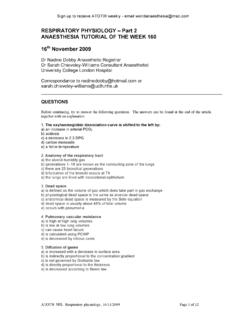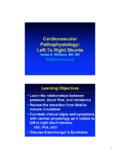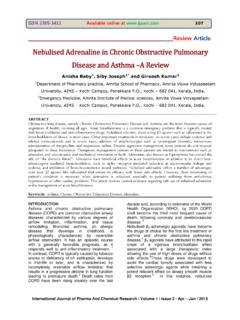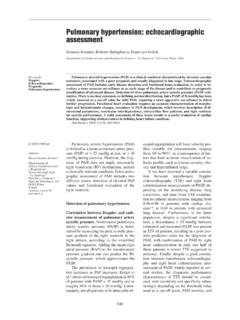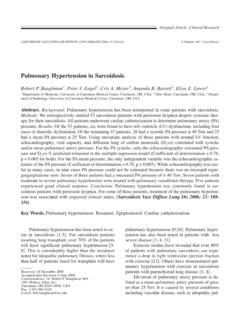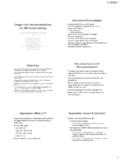Transcription of Pulmonary Function Tests - Columbia University
1 Pulmonary Function Tests PFT Interpretation The interpretation of lung Function Tests involves two tasks: 1) the classification of the derived values with respect to a reference population and assessment of the reliability of the data; and 2) the integration of the obtained values into the diagnosis, therapy and prognosis for an individual patient. ATS/ERS TASK FORCE: STANDARDISATION OF LUNG Function TESTING''. Eur Respir J 2005; 26: 153 161. Pulmonary Function : Tests Dynamic Function : obstructive defects Static Function : restrictive defects Diffusion abnormalities (gas exchange).
2 Spirometry and Maximal Expiratory and Spirometry Inspiratory Flow Volume Curves Dynamic Function . 1. Obstructive Ventilation: Expiratory Decrease in expiratory airflow (volume and/or rate of flow). FEV1 decreased FVC normal or decreased FEV1/FVC decreased*. FEF25-75 decreased *definition of obstructive defect Types of Airflow Obstruction Bronchoconstriction Dynamic airway compression (FVC vs SVC). Emphysema: FVC < slow or inspiratory VC, and plethysmographic volumes greater than gas dilution volumes Upper Airway Small Airways Mixed . 2. PFT Question #1. FEV1 /FVC=obstructive ventilatory defect: Why is FEV1 itself NOT diagnostic of an obstructive defect?
3 Upper Airway Obstruction 3. Upper Airway Obstruction Lung Volumes Static Function . Gas Equilibration ( wash in and wash out ). Body plethysmography Gas Equilibration Lung Volumes Wash in: Helium (insoluble gas) breathed from a reservoir of known VOLUME and CONCENTRATION, thus diluting its concentration by the volume of the lungs VFRC = Vreservoir x Conc INIT Conc FINAL/ Conc FINAL. Gas Equilibration Lung Volumes Plethysmographic Lung Volumes Wash out: Lung gas (N2) washed out P1V1=P2V2 in a closed system at same during breathing of 100% O2 temperature Initial N2 concentration known Lungs and airway closed system when (atmospheric); volume and N2 occluded concentration of expired gas measured Panting at FRC: inhalation=decreased VFRC=VEXP X conc EXP/.
4 79- Conc ALV (final) intrathoracic pressure, increased volume 4. Plethysmographic Lung Volumes VFRC=V / P (PFRC- P ) where P is negligible c/w PFRC. VFRC= V / P (PFRC). P obtained from change in mouth pressure against occluded valve V obtained from change in pressure in the plethysmograph as air in the box is compressed by increase in lung volume PFT Question #2. Measurement of Alveolar In airways disease ( , emphysema), if gas dilution is not complete, how will lung Volume (VA). volume measurement be affected? VA pleth > VA He rebreathe > >VA He single breath VA He rebreathe > VA single breath correlated with decreased FEV1/FVC, increased RV/TLC.
5 Restrictive Ventilation PFT Questions #3 and #4. A decrease in lung expansion Why is FVC itself NOT diagnostic of a FEV1 decreased restrictive ventilatory defect? FVC decreased Why is VC itself not diagnostic of a FEV1/FVC normal or increased restrictive ventilatory defect? Total Lung Capacity (TLC) decreased*. * Definition of restrictive ventilatory defect 5. Types of Restrictive Defects Restrictive patterns Parenchymal removal/destruction Diffuse parenchymal disease, thoracic cage Parenchymal infiltration restriction: symmetric decrease in TLC, Extrapulmonary deformity VC, FRC, RV.
6 Neuromuscular weakness: IC mainly Reduced force generation decreased; TLC and VC decreased and FRC and RV spared Diffusing Capacity (Transfer Factor). Diffusing Capacity for CO (DLCO) Diffusing Capacity for CO (DLCO). DLCO = CO rate of uptake (ml/min)/ PCO DLCO (if transfer factor, TLCO) calculated as the product of (mmHg) the rate constant for CO uptake (called kCO, the Krogh O2 and CO combine with Hgb; therefore reflect coefficient) and alveolar volume, divided by effective gas properties of alveolar-capillary membrane, and its pressure (PB-PH20), expressed as units of conductance uptake therefore limited by resistance across this (eg, ml CO/min/mmHg).
7 Interface Soluble gases limited by Pulmonary blood flow Thus, DLCO =(kcOxVA)/(Pb-PH20). 2 major resistances therefore: membrane properties (Dm), and reactive conductance This assumes what the conductance would be if 100% of (molecular conformation/rate of reaction alveolar volume was filled with CO (that is the VA component properties of Hgb binding x Pulmonary capillary is the volume of distribution). blood volume (Vc).. 6. SB Diffusing Capacity for CO. Diffusing Capacity for CO (DLCO). (DLCO) Inspirate CO, 10% inert gas, 21%O2, balance N2. Expire to RV; inhale rapidly to TLC; hold for remainder of 10 seconds of breath hold time (BHT).)
8 Diffusion determinants: Gas gradient, Expire; discard anatomic dead space gas;. solubility, hemoglobin, membrane sample 500-1000 ml alveolar gas thickness, surface area Diffusing Capacity Increased in alveolar hemorrhage, obesity, asthma??, altitude (since CO and O2 in competition, altitude decreases PIO2 and increases DLCO). Decreased in emphysema (destruction and/or non- equilibration), restrictive disorders (all:why??), Pulmonary vascular disorders, anemia, abnormal Hgb Single breath (10 sec) vs steady state/rebreathe techniques: SB may UNDERESTIMATE true diffusing capacity in emphysema if it underestimates gas dilution VA since DLCO.
9 =(kcOxVA)/(Pb-PH20. DLCO Pearl Isolated DLCO decrease: suspect Pulmonary vascular disorder Or, interstitial disorder not yet, or no longer, affecting parenchymal volume Or, abnormality of Hgb (eg, anemia, carboxyhgb, methhgb). 7. Pre-operative Pulmonary Pre-operative Pulmonary Assessment: PFTs Assessment: PFTs Complications: highest for thoracic and Spirometry: FEV1 or FVC <70%, upper abdominal (ie, near the diaphragm) FEV1/FVC<65%. All having lung resection, orthopoedic and PaCO2>45 mmHg, DLCO<40% in COPD. lower abdominal with lung disease, or None contraindicate smoking Lung resection: FEV1 best for Pulmonary Age>60 years reserve and post op complications; post op FEV1 <30% predicted=increased long term mortality and immediate post op problems PFT Summary Series ATS/ERS TASK FORCE: Obstructive ventilatory defect: decreased STANDARDISATION OF LUNG.)
10 FEV1/FVC. Restrictive ventilatory defect: decreased TLC. Function TESTING'' Edited by Low DLCO: abnormal uptake of gas by Hgb V. Brusasco, R. Crapo and G. across alveolar capillary membrane: Diffusion Viegi. General considerations for determinants= Gas gradient, solubility, hemoglobin, membrane thickness, surface area lung Function testing Disorders with airway dysequilibration (emphysema): gas dilution will underestimate Eur Respir J 2005; 26: 153 161. lung volumes (and ? DLCO). When you can't breathe, nothing else matters.. 8.










